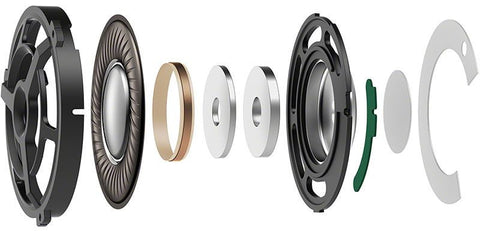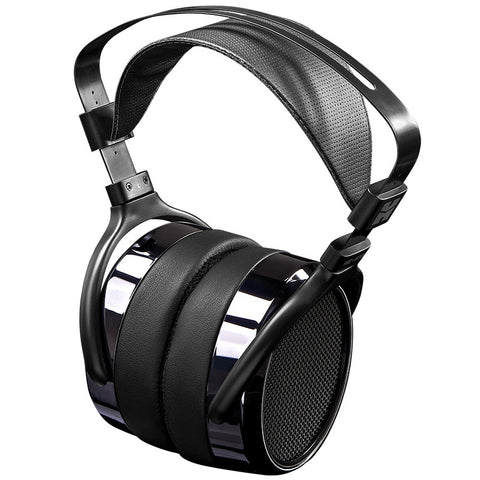Vinyl + headphones: getting started
If you’re reading this, there’s a good chance you: (a) care about how your records sound, (b) expect great value out of your audio equipment, and (c) enjoy cranking up the volume once in a while. If this sounds like you, then you may want to consider pairing your turntable with a good pair of headphones. Plenty of folks use headphones to listen on-the-go. But with the right equipment, they can also be a great fit for your home turntable setup.

Do headphones sound better than speakers?
Speakers are the more popular choice for vinyl playback, but headphones offer some unique benefits:
- No-hassle, accurate soundstage presentation: No need to worry about room acoustics, speaker placement, or toe-in. Headphones can provide an excellent environment for music no matter where you are.
- Get more bang-for-your-buck: There are some great headphones available in the $100-200 price range. It can be tough to find a great amp and speakers for a comparable price.
- Get along better with your neighbors: If your roommates are anything like mine, they probably don’t share your enthusiasm for medieval rock or screamo blaring through your speakers. Your roommates may end up loving your new headphones as much as you do.
As with most things in life, headphones have their drawbacks:
- Less forgiving: Accurate sound reproduction can be a double-edged sword. Headphones may bring out more musical detail, but they can also reveal new surface noises and flaws in your records.
- Loneliness: Believe it or not, there are people who share your enthusiasm for medieval rock and screamo. Sharing musical experiences with those like-minded souls can be a rewarding experience, but headphones won’t help get you there.
How do I connect headphones to my turntable?
You usually won’t be able to plug your headphones right into your turntable. Instead, you will need a headphone amplifier to drive your 'phones (as well as a phono preamp to boost the turntable’s output to line level - just like you would if you were using speakers).
When it comes to choosing a headphone amp, you have a couple options:
-
Dedicated headphone amp: These amplifiers are designed specifically to drive headphones. Because they only have one job to do, headphone amps typically offer better sound quality for your dollar compared to integrated amps or stereo receivers. They are also better suited for headphones that are difficult to drive. If you want to listen on headphones and through powered speakers (at different times of course), you may want to consider a headphone amp with line-level RCA outputs like the Schiit Magni 3.
Our headphone amp pick: Schiit Magni 3 ($99)

-
Integrated amplifier with headphone output: Many integrated amps (e.g. stereo receivers) have a built-in headphone amp. These amps will usually have a headphone jack on the front. This is a good option if you have a few audio sources you want to listen to through headphones. In general, the sound quality will not be quite as good as a dedicated headphone amp.
Integrated amp pick: Onkyo A-9010 ($349)

What kind of headphones should I use?
Choosing your perfect pair of headphones ultimately comes down to personal preference, so we recommend demoing them yourself to see what sounds and feels best to your ears. There are several types of headphones available - each with their own pros and cons:
-
Headphone type
Earbuds & IEMs: These are small headphones that sit in your outer ear (earbuds), or actually fit inside your ear canal (in-ear monitors AKA IEMs). There are some high-quality IEMs and earbuds out there, but these are usually not used for at-home listening.
Full-sized: Broadly speaking, these are headphones that sit on or around your ears. There are three main variables to consider when choosing full-sized headphones: driver type, back type, and ear fit.
-
Driver type
Dynamic: These have cone-shaped drivers - essentially smaller versions of the drivers found in most speakers. This is the most common driver for full-sized headphones, particularly at lower price points.

Planar: These have flat drivers, constructed with a thin film placed between rows of bar magnets. Often regarded as providing more “presence” and detail than dynamic drivers.

-
Back type
Dynamic: The driver is fully enclosed, which minimizes sound leakage and improves isolation. The outer wall of the headphone reflects sound back towards your ear. Bass tends to be more prominent but less focused than with open-back headphones.
Open: The driver is left exposed to the air. To some, this sounds more natural and delivers a wider soundstage. The open-back design doesn’t offer much isolation - so you can still hear the world around you, and other people in the room will hear your music.
-
Ear fit
Circumaural: These headphones have pads that completely enclose your ears. This snug fit offers good isolation. Very little sound gets in or comes out. Many folks find these comfortable because they put very little pressure directly on the ear - making them a great choice for long listening sessions.
Our circumaural pick: Hifiman HE-400I ($449)

Supra-aural: The pads sit directly on your ears (not around them). Isolation is generally poorer than with circumaurals. This design puts some pressure on your ears, which can get uncomfortable after a while. Supra-aurals are more popular for on-the-go listening and settings where you might not want to completely shut out the environment.
Our supra-aural pick: Grado SR60e ($79)

How do I know if my headphones will work with my amp?
You want to be sure that your headphone amp has enough power to drive your headphones - otherwise, you may not be able to reach your desired volume level. The specs to look for are (a) headphone sensitivity (usually given in dB/mV) and (b) maximum power output of the headphone amplifier at the impedance of the headphones. Using some math, you can use these specs to determine the maximum volume level that your headphone/amp combo will provide.
To simplify the process, this website has a helpful tool that lets you plug in your headphone/amp combo to see if they will be a good pair. Specifically, it will tell you the peak SPL (i.e. the max volume level) you can expect. For most types of music and listening preferences, a maximum level of around 110 dB SPL is plenty of volume. You may want more, but be careful - the threshold of pain starts at 120 dB.
Do you have a favorite headphone amp or pair of headphones? Let us know in the comments below!



